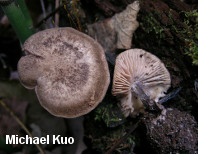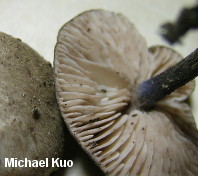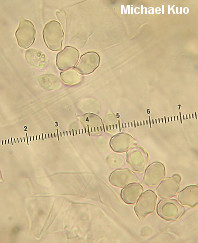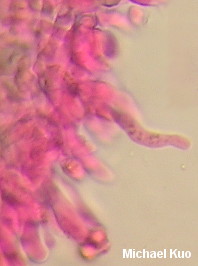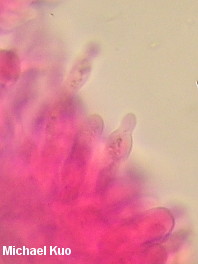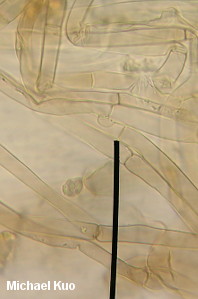| Major Groups > Gilled Mushrooms > Pink-Spored > Entolomatoid Mushrooms > Entoloma tjallingiorum |

|
Entoloma tjallingiorum [Basidiomycota > Agaricales > Entolomataceae > Entoloma . . . ] by Michael Kuo Entoloma tjallingiorum is a wood-inhabiting entolomatoid mushroom with a fibrillose to scaly brown cap and a gorgeous purple-blue, roughened stem. Microscopic features, which should definitely be ascertained for positive identification, include distinctive heterodiametric spores that have very shallow angles between the sides, cheilocystidia, and pileipellis elements with intracellular pigment. Similar species include several brown-capped, blue-stemmed species with smooth stem surfaces (including Entoloma placidum and Entoloma wynnei), and Entoloma dichroum, which has a purplish cap and a smooth to finely fibrillose stem. All of these look-alikes, however, feature spores with sharper angles. Entoloma dichroum in the sense of some authors is the same species. Noordeloos (1982) notes that confusion over Persoon's original concept of Entoloma dichroum (1801) began as early as Fries (1849), when authors began substituting a brown-capped, rough-stemmed species for what Persoon had originally described as a purplish-capped, smooth-stemmed mushroom; therefore, Noordeloos resuscitated Persoon's concept for Entoloma dichroum and described the misnamed mushroom as a new species, Entoloma tjallingiorum. Largent (1994) reports Entoloma tjallingiorum from high-elevation conifer logs in California, Colorado, and New Mexico--but the species he describes differs in substantial ways from Noordeloos's original concept: it lacks cheilocystidia, has "violaceous blue to very pale bluish" young gills, has a "pungent" odor, and features a 1-2 cm cap that is brown "on a violaceous background." Noordeloos's original European, low-altitude, primarily hardwood-inhabiting Entoloma tjallingiorum has cheilocystidia and white young gills, lacks an odor, and features a 2-8 cm brown cap that only sometimes demonstrates a bluish to purplish "tinge." Description: Ecology: Saprobic; growing alone or gregariously on the well-rotted, mossy deadwood of oaks; fall; North American distribution uncertain (the illustrated and described collection was made in Illinois; see also the comments above about Largent's report of the species in western North America). Cap: 2-5 cm; planoconvex; dry; finely scaly (especially over the center) and radially fibrillose; grayish brown; the margin not lined. Gills: Attached to the stem; close or nearly distant; whitish to buff at first, becoming pinkish. Stem: 2-6 cm long; 3-8 mm thick; slightly enlarged toward the base; dry; finely fibrillose to finely scaly; blue at the apex, brown below. Flesh: Thin; whitish; unchanging when sliced. Odor and Taste: Odor not distinctive, or slightly fragrant; taste not distinctive. Chemical Reactions: KOH on cap surface negative, then slowly gray. Spore Print: Pink. Microscopic Features: Spores 9-11 x 6-7.5 µ; mostly 6-sided; heterodiametric, with shallow angles; smooth; hyaline. Pleurocystidia absent. Cheilocystidia cylindric to subutriform or subfusiform; apices rounded; to 50 x 7.5 µ. Pileipellis a cutis; elements hyaline to brownish in 10% ammonia; pigment intracellular. Clamp connections present. REFERENCES: Noordeloos, 1982. (Moser, 1983; Noordeloos, 1988; Largent, 1994; Noordeloos, 2008.) Herb. Kuo 10210901. This site contains no information about the edibility or toxicity of mushrooms. |
© MushroomExpert.Com |
|
Cite this page as: Kuo, M. (2014, January). Entoloma tjallingiorum. Retrieved from the MushroomExpert.Com Web site: http://www.mushroomexpert.com/entoloma_tjallingiorum.html |
